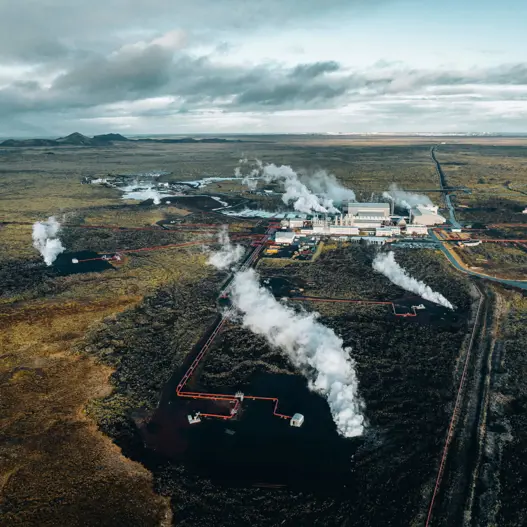The concentration of carbon dioxide in the atmosphere is now a quarter higher than in the early days of HS Orka and fifty percent higher than before the days of the industrial revolution, when the burning of fossil fuels began in earnest. The consequence is a disruption of the carbon cycle. The international community must come together to face this challence and the goal has been set to keep global warming within 2°C, but preferably within 1.5°C.

HS Orka has committed to reduce the company's emissions intensity by 40% by 2030 (compared to 2014). It amounts to a goal of reducing emissions to 26 g of CO2 per kilowatt-hour of electricity produced and heat sold. In the classification regulation of the European Union (EU Taxonomy), emissions must not exceed 100 g CO2ig/kWh for an investment in energy to be considered a sustainable investment.
The company has already taken steps towards lowering its emissions intensity by improving the use of resources, and the recent expansion of Reykjanesvirkjun is an example of that. Increased activity in the Resource Park will also play a major role in reducing HS Orka's emissions intensity by improving the utilization of the heat generated in the energy production. In 2022, the emissions intensity was 34 g CO2ig/kWh.

The geothermal fluid from which thermal power plants produce energy contains the greenhouse gases carbon dioxide and methane. The chemical content of the geothermal fluid is measured regularly, and based on the amount, HS Orka's emissions are estimated in CO2-equivalents. Direct emissions from HS Orka's power plants were 94,594 tons of CO2-equivalents in 2022, of which methane was 243 tons. These emissions amount to 97% of the company's total emissions.
The emission of greenhouse gases due to fossil fuel use was 144 tons and decreased by 13% between the years 2021 and 2022, mainly because the percentage of clean energy vehicles increased by 13%. Emissions due to waste treatment were measured at 73 tons and increased by 7% year-on-year, which can be considered moderate in light of the expansion of Reykjanesvirkjun and the corresponding increase in the amount of waste. Emissions due to purchased materials related to the expansion of Reykjanesvirkjan and oil use in earthworks due to construction in Svartsengi was 4,002 tons in 2022. HS Orka purchased carbon offsets in accordance with Kolviður´s methods and rules against the company´s emissions from air transport, waste treatment and part of its vehicle usage.
Energy transition
In order to achieve the goals of reducing greenhouse gas emissions, the international community needs to take multiple actions. The best solution is to phase out fossil fuels and increase the share of renewable energy sources, especially in energy production and transportation. HS Orka's core business is the production of renewable energy, which is a fundamental aspect of the energy transition. In addition to the energy production itself, the company now offers charging stations for cars, and rapid development is expected towards the electrification of boats and larger vehicles. In addition, there are underutilized opportunities in connection with electric fuels, and HS Orka is involved in the development of such projects at the level of the Resource Park. Some of the projects involve utilizing carbon dioxide that would otherwise be released from the company's geothermal power plants.
Strategy
HS Orka is working to integrate its commitment to carbon neutrality in 2040 with development projects aimed at utilizing the company's CO2 emissions. The biggest projects concern the production of electric fuel. Alongside the development of those projects HS Orka will continue to explore the feasibility of other options to ensure that the goal of carbon neutrality is achieved.
